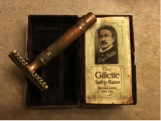This blog although a Freestyle will closely relate to the Stock option however, it will take a different approach. For example, instead of presenting old-school technology to a younger generation that may not adequately recognize or understand, I will present old-school technology to that same generation that he or she will understand or more adequately recognize. The questions of concern being why these old-school technologies still exist and have become a staple competing still with modern technology? I will discuss three in particular such as Ray-Ban’s Wayfarer sunglasses, Gillette Safety Razor, and Converse Chuck Taylor shoes. A person could argue the former are mere products and not so much technologies but to understand my angle I see these as technologies each in their respected fields. Take for instance Wayfarer sunglasses being in the field of optics and frame technology, Safety Razors being in the field of shaving and blade technology, and Chuck Taylor’s in the field of shoe technology.
Ray-Ban Wayfarer’s were first issued in 1952 and have since then been popular among celebrities, artist, and the general population (“Original Wayfarer”). Furthermore, since its inception the Wayfarer has inspired other brands to design similar sunglasses because of its sleek eye catching style (Wikipedia contributors). Flash-forward to today, Ray-Ban has the same original design along with variations of the original design. I myself own a pair of the New Wayfarer, a smaller frame of the original design.
Figure 1: All images from Google Image Search. Click Image for link.
Gillette’s Safety Razor’s came into to market around 1901-1904 when King Camp Gillette obtained a patent for his invention (Wikipedia contributors). Moreover, Gillette’s design much like the Wayfarer has inspired various brands to follow suit. For example, although Gillette no longer sells safety razors in the US other brands such as Merkur continue to sell double edge safety razors thus maintaining the tradition of shaving like grandpa alive.
Figure 2: All Images from Google Image Search. Click Image for Link.
Chuck Taylor shoes are a good example of an unchanged long lasting technology still favored by many of all ages. Complex magazine in 50 Things You Didn’t Know About Converse Chuck Taylor All Stars states the following:
The Converse Chuck Taylor All Star — formerly just the All Star — has been in constant production since 1917, and has gone virtually unchanged since 1949. Its gone from the world’s most prevalent basketball sneaker to a lifestyle staple (Bengtson, and Engvall).


Figure 3: All Images from Google Image Search. Click Image for Link.
Furthermore, these shoes like the former products mentioned have inspired other brands to create similar style of shoes. All three technologies have outlasted the test of time, evolution of style, competition, and evolved technologies. What is further interesting is that people of all ages and both genders use them. Perhaps an exception could apply to the safety razor although there is a range of ages that use the product as well. I myself shave with one and it goes to show how a younger generation is using an old-school technology given coexisting shaving technology. In closure, what is relevant about these technologies is their ability to succeed into the future given modern technologies and social changes. Lastly, the importance of these technologies is the ability to learn from them how a product can be designed to last generations despite social, economical, political, cultural, and style changes.
Work Cited
“Original Wayfarer.” Ray-Ban. Ray-Ban. Web. 19 Mar 2014. <http://www.ray-ban.com/usa/sunglasses/RB2140 unisex 1-ORIGINAL WAYFARER CLASSIC-Black/805289126591>.
Wikipedia contributors. “Ray-Ban Wayfarer.” Wikipedia, The Free Encyclopedia. 23 Feb 2014. <http://en.wikipedia.org/wiki/Ray-Ban_Wayfarer>.
Wikipedia contributors. “Safety Razor.” Wikipedia, The Free Encyclopedia. 5 Mar 2014. <http://en.wikipedia.org/wiki/Ray-Ban_Wayfarer>.
Bengtson, Russ, and Nick Engvall. “50 Things You Didn’t Know About Converse Chuck Taylor All Stars.” Complex. Complex, 28 May 2013. Web. 20 Mar 2014. <http://www.complex.com/sneakers/2013/05/50-things-you-didnt-know-about-converse-chuck-taylor-all-stars/>.





